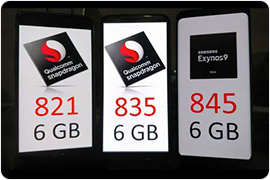What Is 5 GHz WiFi And How Is It Different from 2.4 GHz
By Carrie Tsai, Last Updated: July 31, 2020TIPS
Nowadays, WiFi routers are everywhere from offices to homes so that individuals can use WiFi networks almost anytime, anywhere. However, it seems that people still don't know much about WiFi network. If you're connecting to a WiFi on the Network Finder, you may come across monikers like "My Network - 5G". This is confusing since 5G, the new generation mobile network technology, is on the cusp of launching by many vendors in consumer electronics. In fact, 5G which is associated with WiFi is short for 5 GHz WiFi.
It isn't surprising that you may still be in bewilderment since it's the fact that both 5G and the 5 GHz WiFi can provide wireless connectivity. And you may be more confused if you also view WiFi networks on the Network Finder labeled with "2.4 G/2.4 GHz".
Well, don't fret. The article is going to solve all the mysteries for you by pointing out the difference between 5G and 5GHz WiFi as well as making a comparison between 2.4 GHz and 5 GHz WiFi. After that, it'll also guide you how to pick between 2.4 GHz and 5GHz WiFi. Just be relaxed and continue to read.
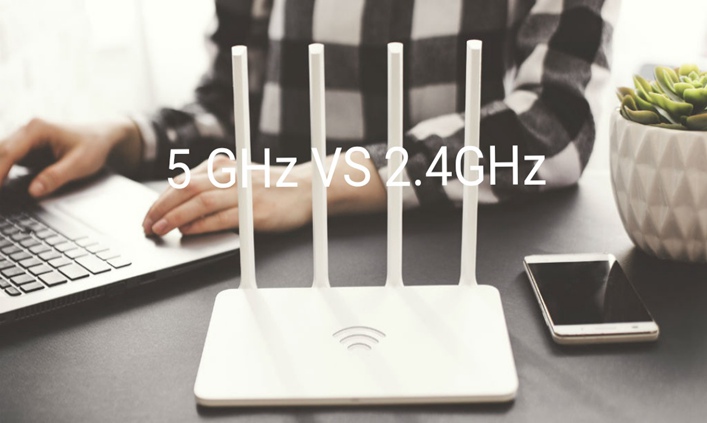
You May Also Take Interest in:
How to Pick the Right WiFi Router to Improve WiFi Speed
What is MiFi and How To Use MiFi Hotspot?What is 5G? And How About 5G Mate 20X VS 4G P30 Pro
5G Phone: Every Known Phone and Shall you Buy?
MediaTek Complete the 5G Multimode Modem Chip Helio M70
5G VS 5 GHz WiFi : Are They the Same
As mentioned earlier, the labeled "5G" in the term dubbed "My Network - 5G" on the Network Finder is short for 5 GHz WiFi. This moniker has absolutely nothing to do with 5G Cellular which is on the cusp of releasing in consumer devices. However, they have one thing in common - they both grant wireless connectivity between devices. Anyway, let's explore what they are to find out their difference.
What Is 5G
5G is, essentially, the 5th generation of cellular network, which improves on 4G that most mobile data users have on their phones now. It isn't difficult for you to understand 5G cellular since you must have gained some understanding about its predecessors 4G as well as 3G. Also, it's most likely that you've heard about 5G mobile and perhaps you've viewed some 5G phones released.
As the totally redesigned version of mobile networking, 5G will require completely new infrastructure but aims to provide ultra-fast network connection speed to wireless devices. All these will allow 5G to offer improvements over 4G and become the new mobile network standard, which will eventually enable 5G to make scores of different industries become better.
What Is 5 GHz WiFi
5 GHz WiFi is, in essence, a WiFi signaling frequency band in which a WiFi network can transmit data. Depending on the WiFi router, there are two different WiFi frequency bands - 2.4 GHz and 5 GHz. But prior to getting to understand the 5GHz WiFi, it's of great necessity to know about how WiFi works in order to make the following understanding of the 5GHz WiFi become much easier.
Much like mobile networks, WiFi networks transfer data to the WiFi-connected devices in the form of radio waves. As one type of electromagnetic waves, radio waves include a wide frequency range (~3 KHz to 300 GHz), which changes in this range called frequency band. As to the main frequency bands for WiFi use, they are the 2.4 GHz (2.4 to 2.5 GHz) band and 5 GHz (5.180 GHz to 5.825 GHz) band.
Now it can be easily understood that the 5GHz WiFi network works to transfer data by utilizing radio waves between the frequency range of 5.180 GHz and 5.825 GHz. It's worth noting that 5 GHz WiFi signals are only available on your WiFi-connected device in the WLAN 802.11 a/n/ac standard. Moreover, it's composed of 24 different channels, each of which is 20MHz wide.
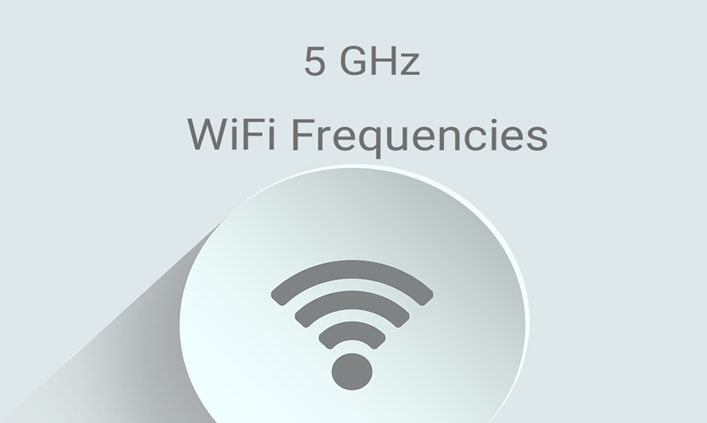
In one words, 5 GHz WiFi is absolutely not the same as 5G. Although it cannot be denied that they both provide wireless connectivity, they, in fact, have nothing to do with each other. 5GHz WiFi is a WiFi signaling frequency band while the so-called 5G is the 5th generation mobile network technology.
Why Are Some WiFi Networks Labeled with or Described as "5G"
As to the reason why some WiFi networks are often labeled with "5G", it actually boils down to some WiFi routers which can support both 2.4 GHz and 5 GHz WiFi at once. "5G" following terms like "My Network - " or associated with WiFi is just short for 5 GHz WiFi. The reason why "5G" and "2.4G" are always labeled with WiFi Networks names lies in the fact that many devices, in reality, when connecting to the WiFi routers which support both 2.4GHz and 5GHz WiFi at once (dual-band WiFi routers), cannot properly switch between the WiFi networks and choose the right one.
Therefore, in order to identify two WiFi networks and to manually select which network you want to connect to your devices, people always configure their WiFi routers to have two different WiFi network names which are labeled with "5G" and "2.4G".
These monikers weren't too misleading back in the days when 3G and 4G mobile network took the dominant position in cellular standards since they were just the shorter names people used for convenience. However, since 5G, the 5th generation mobile network come along, it makes the "5G" labeled with WiFi network a bit more confusing. But keep remembering that "5G" labeled with or associated with WiFi networks is just short for 5GHz which is a WiFi frequency band.
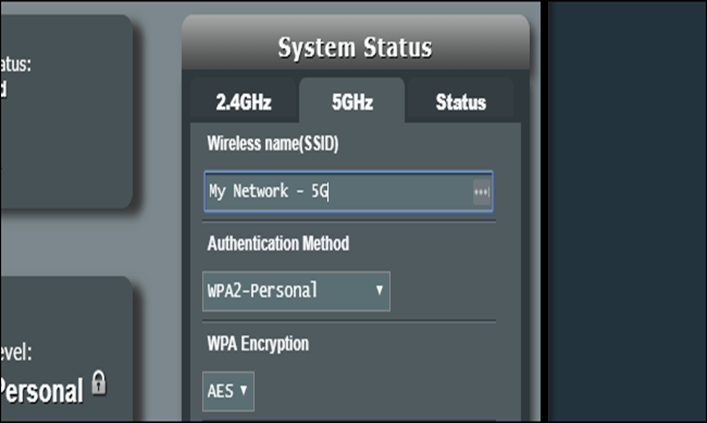
2.4 GHz VS 5 GHz WiFi: What's the Difference
Now it has been manifest that WiFi networks use radio waves in either the 2.4 GHz or 5 GHz frequency band to transfer data to the WiFi-enabled devices. But what's the difference between these two WiFi frequency bands? Well, it all boils down to network speed, network range as well as network interference. Let's have a look.
2.4 GHz VS 5 GHz WiFi: Network Speed
The primary difference between these two WiFi frequency bands is network transmitting speed. Generally, the general rule of thumb is that the higher the frequencies, the faster the data can be transmitted. Therefore, the 5 GHz WiFi in higher frequencies allows data to be transferred much faster than the 2.4 GHz. That is, by linking with a 5GHz WiFi network, your device can enable you to play games, download files or download videos in a much faster speed.
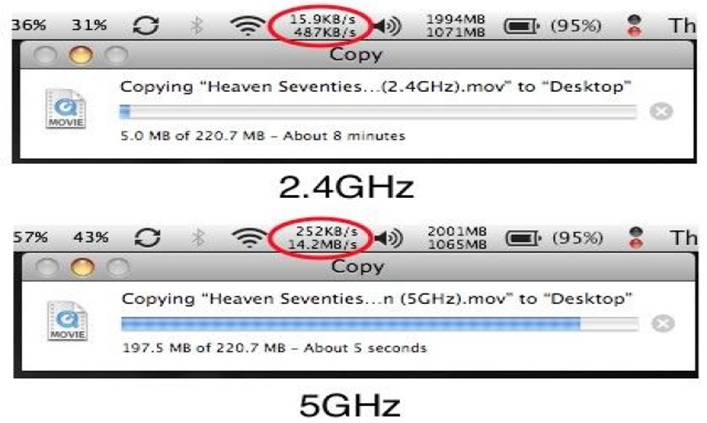
2.4 GHz VS 5 GHz WiFi: Network Range
The level of signal frequency also determines the network range (coverage). In principle, the higher the signal frequency, the shorter the radio waves and the shorter the network range. Hence, 5 GHz WiFi network gets a shorter effective network range than the 2.4 GHz.
Besides, the shorter radio waves also make the 5GHz WiFi less capable of penetrating solid objects and walls, which limits its coverage range especially inside homes. On the contrary, 2.4 GHz WiFi in longer waves is more able to penetrate solid objects, making it better suited to longer ranges.
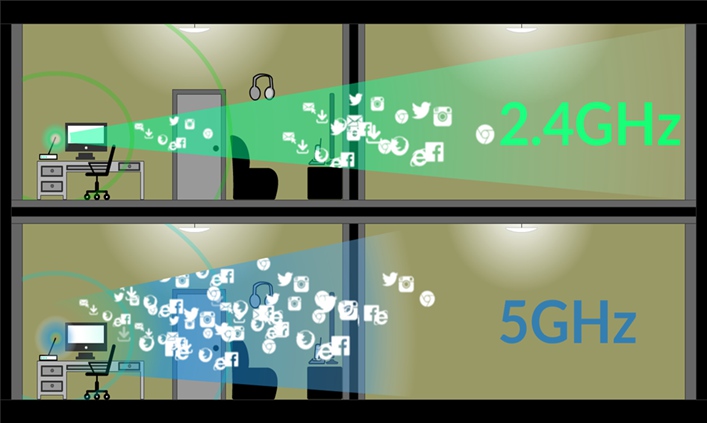
2.4 GHz VS 5 GHz WiFi: Network Interference
There is another difference between these two WiFi frequency bands which also effects their network speed - network interference. The 2.4 GHz WiFi frequency band is commonly applied in a great number of consumer products especially household appliances, cordless phones, baby monitors as well as garage door openers. This means that the 2.4 GHz band is much more congested and can easily suffer interference from consumer products using 2.4 GHz band, which can easily cause dropped connections and slow-down WiFi network speed.
Contrary to 2.4 GHz, the 5 GHz frequency band is much less overcrowding since there are fewer devices using it, leading to more stable connection, less latency, as well as faster WiFi network speed. Besides, the 5GHz WiFi owns 24 channels while the 2.4 GHz only has 11 channels, which also makes the 5GHz less congested than the 2.4 GHz.
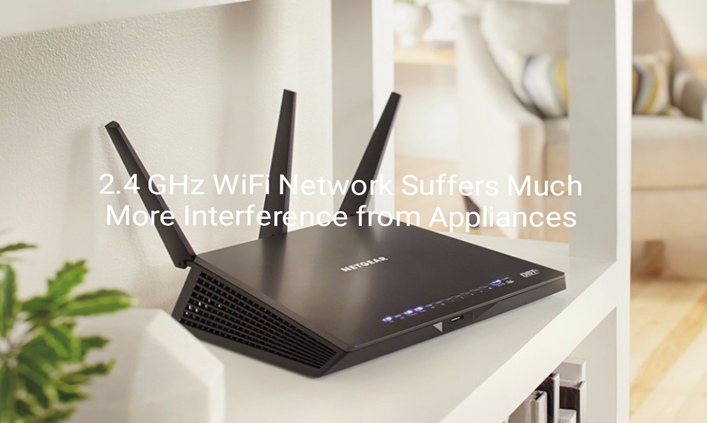
How to Choose the Right WiFi Frequency Band, 2.4 GHz or 5 GHz
From the above comparison, it's clear that both the 5 GHz WiFi and the 2.4 GHz WiFi come with their own pros and cons. That is, sometimes using 5GHz WiFi will be beneficial for you while sometimes vice versa. How to choose the right WiFi frequency band actually depends on the circumstances as well as what you'll use it for. The following are the tips for you to pick the right WiFi frequency band according to different circumstances as well as different needs.
Consider Size of the Using Location
As mentioned earlier, 2.4 GHz WiFi in longer waves supports transmitting data in a greater coverage area than 5 GHz WiFi in shorter waves. Therefore, if you're in larger spaces like your home or your office or in places where there are lots of walls and solid objects, it's advisable that you choose 2.4 GHz WiFi network for it can allow for wider network range.
Otherwise, if you're in smaller places like apartments, it's arguably better that you pick 5GHz WiFi since not only can it allow data to be transferred in a greater speed, but also reducing interference from neighboring networks.
Pay Attention to Interference and Obstacles
Appliances which are placed steadily in your home should be also taken into account since they can be the obstacles of smooth WiFi connection and fast network speed. Household appliances like microwaves, baby monitors and garage door openers always use 2.4 GHz frequency range, making the 2.4GHz band more prone to interference. Therefore, if you have lots of these devices in close proximity of your WiFi router, it's more appropriate to pick a 5 GHz WiFi.
Think About How You'll Use It
After considering the above factors, all you need to do is think about how you'll use the WiFi network. If you just want to connect it to the device on which you'll do low bandwidth activities in most times such as browsing the Internet, then 2.4 GHz band is enough. But if you'd like to do high-bandwidth activities like gaming and streaming movies, 5GHz WiFi is better.
Consider Picking Dual-Band
The majority of modern WiFi routers support dual-band which broadcasts both a 2.4 GHz and a 5 GHz WiFi signal and can allow you to either use one of them at a time (selectable dual-band) or use both of them at once (simultaneous dual-band).
The advantage of simultaneous dual-band WiFi is that it supports using separate WiFi network on the 5 GHz and 2.4 GHz radios signals and automatically switching frequency bands according to different use scenarios. This can help alleviate congestion and competition of the two bands for the same channels and maximize your WiFi network's performance. However, WiFi routers supporting dual-band are a bit more expensive than those supporting only 2.4GHz or 5GHz WiFi radios.
So if you indeed have multiple devices and need to reduce network congestion, you might benefit from spending a bit more on a dual-band WiFi router. Also, if you have interest in it and the price is within your budget, you can have a try. Otherwise, choosing between 2.4 GHz and 5 GHz WiFi is enough.
Final Thoughts
The "5G" labeled with some WiFi networks is, in fact, short for 5 GHz WiFi which is a WiFi signaling frequency band. It has nothing to do with the 5G cellular, the 5th generation mobile network. WiFi networks use radio waves in either 2.4 GHz or 5 GHz frequency bands to transfer data.
Compared with 2.4GHz, 5GHz WiFi has faster network speed, less network range, less capability of penetrating solid objects and less crowded with interference. It's advisable that you choose the right WiFi frequency band according to the circumstances, your purposes as well as your budget. Anyway, hope you enjoy this article.



